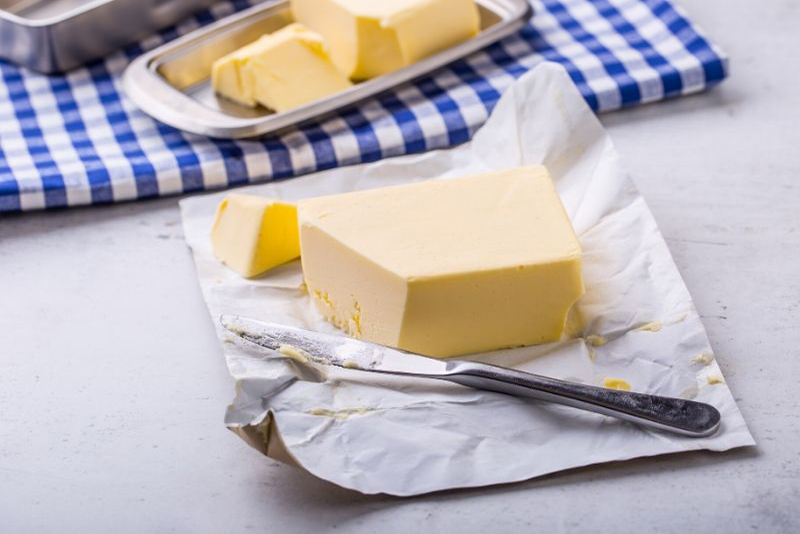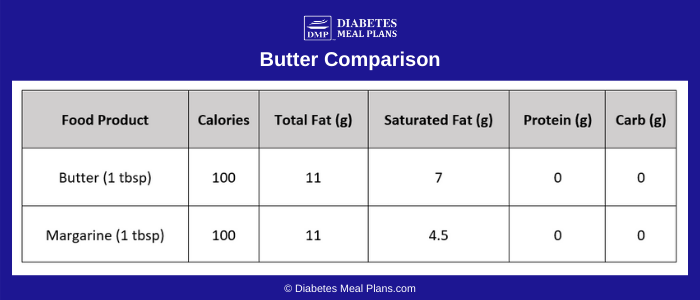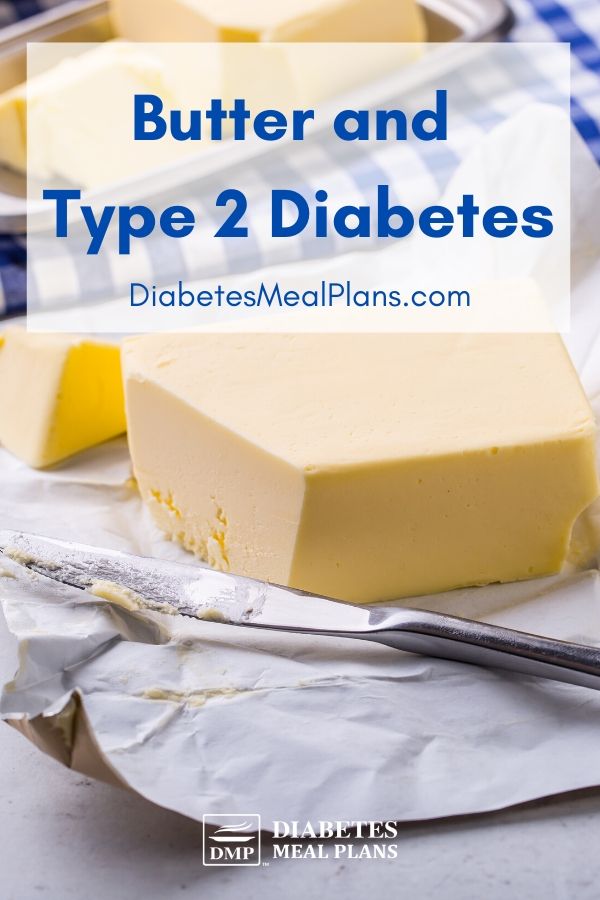Butter has been a topic of heated debate since the 1970’s, with the saturated fat in butter being the main point of controversy.
When you have type 2 diabetes, it’s wise to consider everything you’re putting on your plate and how it could potentially affect your health. So, whats the deal with butter and how does it compare to a substitute like margarine?
Keep reading to learn what butter (and margarine) actually are and how they affect diabetes…

How is Butter and Margarine Made?
Butter is defined as a whole food, which is a solid emulsion of fat globules, air and water made by churning milk or cream – a simple and natural process that people have been doing for centuries.
Margarine is defined as a food ‘product’ usually made from vegetable oils through a refining process called hydrogenation.
Butter came under fire in the 1970’s when saturated fat was linked to increased heart disease risk. Because butter contains a high amount of saturated fat, people started switching to margarine thinking it was healthier.
Nutritional quality was not the main focus for those earlier margarines, and it was soon realized that the trans fats that were produced from the process of hydrogenation were worse for heart disease.
Due to consumer needs and scientific development newer margarines have emerged that are said to be free of trans fats (tube margarine). They are also being produced to contain ‘healthier’ fat options, including fats such as polyunsaturated and monounsaturated fats.
However, keep in mind that margarine is a processed food.
In making margarine, oils are heated to high temperatures, then undergo several processes, including hydrogenation, which changes the structure of the fatty acids. So even if you start out with a healthier oil like olive oil or avocado oil, the end product is still highly processed and stripped of nutrients.
This heating process also generates trans fats which are very unhealthy.
Although margarine now contains less trans fats, not all of it can be removed and even a small amount can be harmful to your health. Heating oils to high heats also increases oxidation, thus increasing free radicals in the body.
This alone is a reason to avoid margarine because oxidation causes cell changes and generates disease in the human body.
Butter vs. Margarine: which is Healthier?
An epidemiology study found there was no benefit in replacing butter with stick margarine or low-fat margarine.
This study also found a lower risk associated with heart attack, coronary heart disease, stroke and blocked arteries when tub margarine was used in place of stick margarine. This makes sense because tub margarine contains lower amounts of trans fats.

Research as found no associated benefit in replacing butter with margarine.
This is mostly likely true because butter is a natural food and margarine is totally processed, so it makes sense that switching from a natural food to a high processed one wouldn’t cause any health improvements.
If you do buy margarine, do not choose a stick margarine because that will be higher in trans fats.
Tub margarine will contain vegetable oils but you need to check that they are trans fat free. Check the ingredients label for ‘hydrogenated’ or ‘partially hydrogenated’ oils. These indicate the food may still contain traces of trans fats, which can still be harmful to health.
Modern margarines can be made to contain higher levels of polyunsaturated and monounsaturated fatty acids and lower levels of saturated fat and trans fat, but you can also get these healthy fats from foods likes walnuts, flax seed, salmon, almonds, avocados and olives.
Our choice would be to choose butter over margarine as it is less processed and a healthy choice within a whole food diet.
Also remember that butter is a fat, so in relation to blood sugar control it is not going to cause your blood sugar to elevate.
How Does Butter Affect Diabetes?
This topic can be very confusing.
We are used to general dietary guidelines telling us to avoid foods that are high in saturated fat, and there is much debate about whether saturated fats are good or bad. This is ongoing due to differences across studies.
One study found that LDL cholesterol (“bad cholesterol) increased after ingestion of a diet that incorporated ~48g of butter daily. This comes to about ~3 tablespoons. However, it also raised HDL “good” cholesterol levels. This indicates butter may be fine to consume for most people, but for individuals who already have high LDL cholesterol, butter may be something to moderate.
One meta-analysis (the highest grade of evidence) found very little association between death, cardiovascular disease and diabetes with butter intake ranging from as little as 4.5g (1 teaspoon) per day to as much as 14g (1 tablespoon) or even 46g (~3 tablespoons) per day.
A study in Europe found that individuals that consumed any butter experienced lower risk of diabetes. Their findings suggested that butter is neutral for diabetes.
The above studies suggest that consuming butter is fine in moderation. Butter can increase HDL “good” cholesterol but can also raise LDL cholesterol, so may need to be moderated in some.

Saturated Fat
When it comes to saturated fat consumption, there is evidence to suggest the source of saturated fat is important to focus on. For instance, consumers often focus on fats they can see such as oils, spreads and dressings. But they do not think about fats in processed foods like certain meats, baked goods and snack foods.
A review from the American Heart Association reminds us that dietary saturated fat can be obtained from a variety of healthy foods and each of these may possess numerous other ingredients and characteristics that modify their health effects.
Studies show intake of meat, milk, cheese and all dairy products have no significant association with heart disease. When you compare that to processed meat, which is associated with increased risk, it becomes clear that eliminating processed food may be more important than eliminating fats in general.
Interestingly, the majority of saturated fat in the western diet comes from junk foods.
Figure 3.4, page 26, of the 2010 US dietary guidelines shows that the main sources of saturated fat are processed food: pizza; grain-based desserts; dairy desserts (ice cream); KFC; hot dogs; burgers; tortillas; candy; potato chips etc. Butter only accounts for 2.9% of saturated fat sources and milk 7.3%.
So there is not enough evidence to support a strong recommendation that people should restrict all food high in saturated fat, particularly if they come from nutrient dense whole food sources.
Conclusion
Our choice would be butter over margarine as it is less processed and a healthy choice when included within a whole food diet.
The above research suggest that consuming butter is fine in moderation. Butter can increase HDL “good” cholesterol but can also raise LDL cholesterol, so may need to be moderated in some.
There is not enough evidence to support a strong recommendation that people should restrict all food high in saturated fat, particularly if they come from nutrient dense whole food sources, butter being one of them.
Butter contains zero carbs, so you don’t have to worry about blood sugar spikes when eating it.
Just keep in mind though, that eating a variety of different fats is important. There are many other options for fats such as virgin olive oil, avocado, olives, nuts and seeds, including seed and nut butters – and these should make up part of your diet too.
For more healthy fat options, check out the “fat” portion of our Diabetes Friendly Food List!

Interesting article. What are your thoughts on mixing butter with avocado oil, equal ratio, so that it would be easier to spread.
Hi Diane,
I don’t see an issue with this but you can also just store small amounts of butter out to make it softer.: )
I had quadruple bypass surgery last year. Following the surgery I attended 2 seminars which was recommended by my Cardiologist and was presented by a nutritionist at the local hospital. Her recommendation was contrary to yours, as she suggested Becel margarine over butter. I recall several years ago when I had been diagnosed with diabetes, the nutritionist suggested the same, ie., Becel over butter. I find these contradictory messages very confusing.
Hello Premila,
Unfortunately, there are still providers that use this out-dated information when working with clients. The research has evolved the past few years and we are learning more about saturated fats vs. vegetable oils. As a nutritionist, I would recommend small amounts of butter over a highly processed margarine.